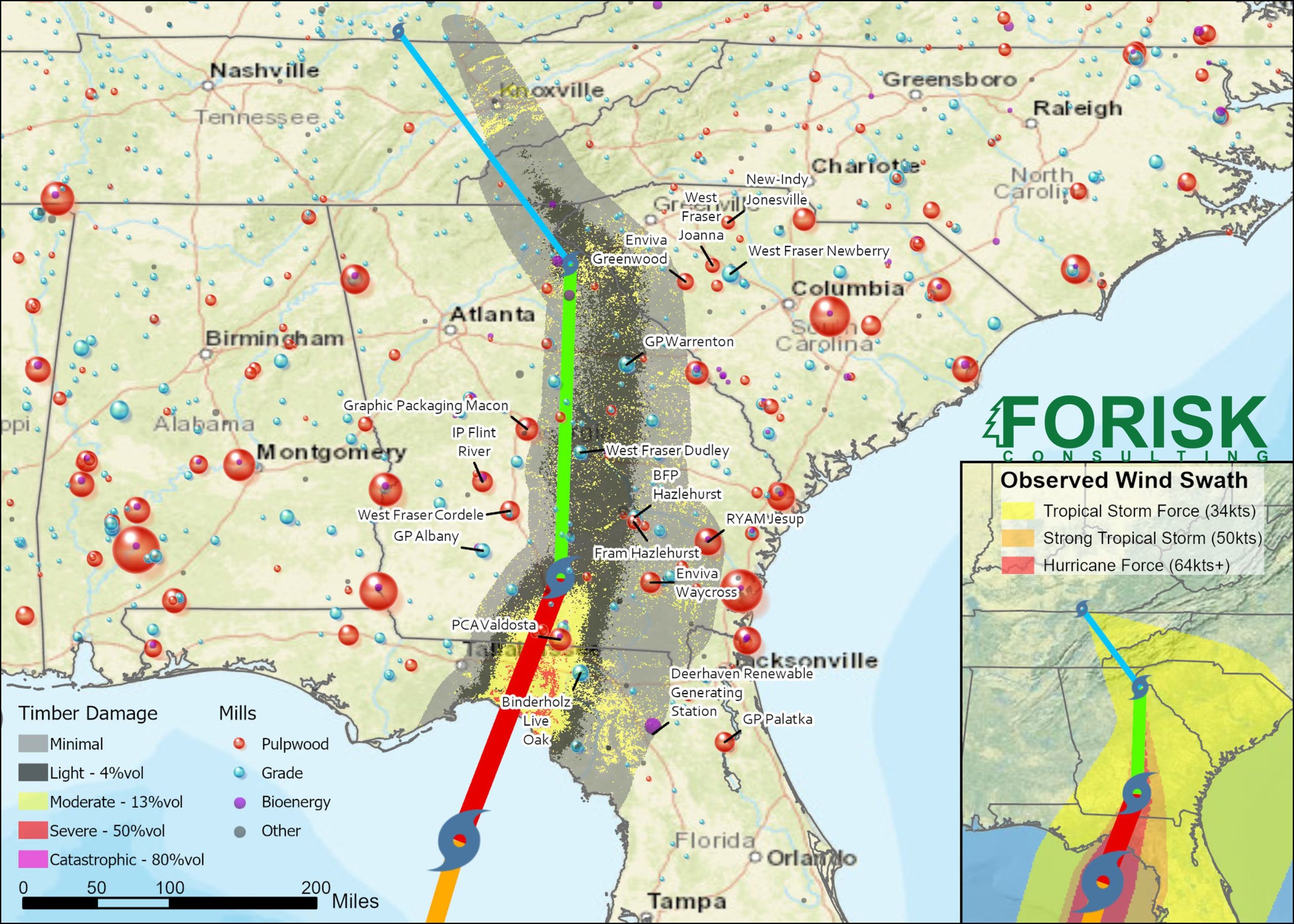This is part two of a series evaluating the impacts of Hurricane Helene on timber markets in Georgia. Part one can be viewed here.
Following Hurricane Helene’s landfall on September 26, 2024, multiple organizations put in a lot of work to evaluate the impacts of the storm on Georgia’s agriculture and forestry industries. The Georgia Forestry Commission (GFC), in partnership with the University of Georgia’s Warnell School of Forestry and Natural Resources, released their final Timber Damage Assessment Report on November 5, 2024. This post draws on information from GFC’s assessment as well as conversations with mills and landowners in the path of the storm.
Timberland
According to the Georgia Forestry Commission, Hurricane Helene traversed 8,931,000 acres of forestland in Georgia, which is approximately 37% of the total timberland in the state. Of the total acres traversed, approximately 1.5 million acres received most of the timber damage from the storm. One procurement manager said, “Helene was more sporadic than Michael. It is like a big giant walked across Georgia. One stand may have 2-3 acres impacted, and the stand next door is unusable.” The GFC estimates that 26 million tons of pine and 30.9 million tons of hardwoods were damaged across the state, which exceeds the average annual harvest volume for Georgia. This has resulted in timber flooding the local market and depressing stumpage prices in the path of the storm. Forisk received reports of landowners receiving as little as $2-3 per ton for their salvage wood, approximately 10% of current pine sawtimber stumpage prices in Georgia. Overall, the GFC estimates a total economic impact of $1.28 billion, nearly double the loss of $763 million from Hurricane Michael in 2018.
GFC found that damage was most severe in thinned chip-n-saw and sawtimber stands. Pulpwood stands sustained moderate to light damage. Pine stands with higher densities and pre-merchantable timber stands suffered less damage than thinned stands with lower densities. Hardwood riparian areas also suffered severe damage due to saturated soil and foliage in the crowns acting as sails in the heavy winds.
Mills
In the Q4 2024 Forisk Research Quarterly, Amanda Lang provided an overview of the impacts Hurricane Helene had on mills in Georgia. Mills in the path of the storm shut down to brace for impact. Mills were down from four to ten days, primarily from power outages, with minimal physical damage to mill infrastructures from the storm. Most mills in the area are buying as much salvage wood as they can, with one sawmill storing pine logs under water to preserve them longer in order to buy more salvage wood. Forisk estimates that 44 mills were in the immediate path of the storm, representing an annual wood demand of 24 million tons (Figure).

Data Sources: Forisk, U.S. Forest Service Geospatial Technology and Applications Center, NOAA, NHC, ESRI.
Market Impacts
Forisk is updating supply models to reflect the impacts of Hurricane Helene on timber supplies in Georgia. These updates will be incorporated in forecasts in the 2025 Q1 edition of the Forisk Research Quarterly (FRQ). The updates will also be incorporated into Forisk’s new Custom Market Forecast (CMF) for firms that have a presence within the path of the hurricane and want to know more about the impact of the storm on their local market area.
If you are interested in evaluating how major events like a hurricane or a mill closure can affect local timber markets, Forisk’s Custom Market Forecast (CMF) can provide detailed insights into pricing and demand trends. The CMF offers customized forecasts to help the forestry industry make informed decisions during times of uncertainty.

Leave a Reply